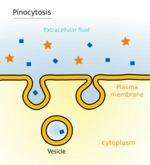Protozoa
|
|
Introduction
All protozoa are unicellular eukaryotic organisms which store their genetic information in chromosomes in a nuclear envelope. Protozoa are classified depending on their structure and life cycle. This reflects the similarities of the diseases which they cause.
Protozoa usually range from 10μm-50μm but can grow up to 1mm. Thus, they are usually observed and classified using a microscope.
Protozoa multiply sexually, asexually and can also use a combination of both, for example, the coccidia class. Replication can be by binary or multiple fission. Different protozoa use different forms of motility, including flagella, cilia, pseudopodia and gliding.
Structure and function
- Motile
- Organelles and otehr cellular structures enable the protozoa to lead an independent exsistence
- Cilia
- Fine, short hairs covering the protozoal surface
- Hairs beat in unison to enable the protozoa to move
- Wafts food towards the cytostome (mouth opening)
- E.g. Balantidium
- Flagellum
- Contractile fibre
- Contracts in a whip like motion to propel protozoa
- Attached to body of protozoa by an undulating membrane
- E.g. Trypanosoma
- Pseudopodia
- Extensions of the cellular cytoplasm
- Cytoplasm flows into the pseudopodia allowing movement of the protozoa
- Also acts in a phagocytic manner surrounding food particles and enclosing it in a vacuole
- E.g. Entamoeba
- Gliding
- No obvious means of locomotion
- E.g. Eimeria
Nutrition and digestion
- Pinocytosis
- Droplets of fluid taken into the cell
- Generates small vesicles
- Usually used for extracellular fluid ingestion
- Requires ATP
- Phagocytosis
- Larger particles of matter taken into the cell
- Usually solid particles ingested
- Cell membrane envelops the fluid or food taking it into the cell
- Lysosomes fuse with the fluid/food initiating digestion
- Diffusion through the cell membrane allows excretion of metabolic products
Life Cycle
- Most protzoal reproduction is asexual using binary fission, schizogony and sporogony
- Some protozoa also use sexual reproduction called gametogony
- In some species, sexual and asexual reproduction occurs in the same host, whilst in others asexual reproduction occurs in the vertebrate host and sexual reproduction in the arthropod vector
- Homogenous
- Parasite uses a single host species during its life cycle (direct)
- E.g. Eimeria
- Heteroxenous
- Parasite uses more than one host during its life cycle (indirect)
- E.g. Trypanosomes
- Facultatively heteroxenous
- Parasite may use more than one host during its life cycle but this is not essential
- E.g. Toxoplasma gondii
Example of a Protozoal Life Cycle
The following refers specifically to the life cycle of Coccidia spp.
- The oocyst is the resistant stage in the environment
- The infective sporozoite is released from the oocyst
- Inside the host, the sporozoites invade the intestinal epithelial tissue
- Sporozoites feed and grow
- As the sporozoites grow the nucleus divides forming a schizont
- The schizont contains numerous elongated merozoites
- The formation of merozoites is the first asexual reproductive stage called schizogony
- The schozont ruptures releasing the merozoites which also invade the epithelial cells
- Another generation of schizonts form which is the beginning of the sexual phase of reproduction called gametogeny
- The merozoites form male microgamonts or female macrogamonts
- Collectively known as gamonts or gametocytes
- The microgamonts released from the microgametocyte penetrate and fertilise the macrogamete (which is contained within the macrogametocyte)
- Gametogeny forms the zygote
- Surrounded by a cyst wall
- Forms the oocyst
- The oocyst is passed in the faeces as unsporulated
- The oocyst becomes sporulated in the second asexual reproductive phase called sporogeny
- Once the oocyst is sporulated it is infective
Protozoa of Veterinary Importance
- Eimeria
- Isospora
- Toxoplasma
- Neospora
- Sarcocystis
Cryptosporidium and Cyclospora
- Theileria spp.
- Trypanosoma spp.
- Leishmania spp.
- Tritrichomonas foetus
- Histomonas meleagridis
- Balantidium
- Entamoeba
- Microsporidia


